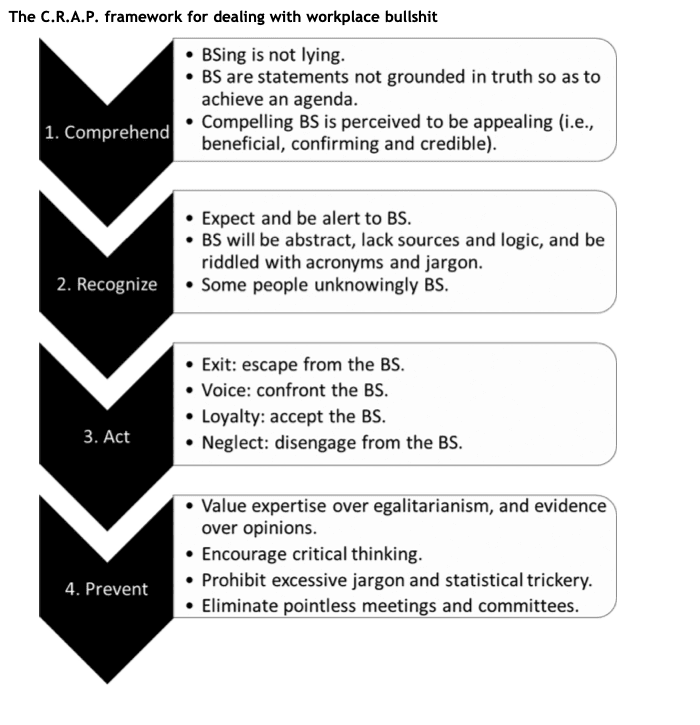Researchers from Canada, Italy and Finland have finally laid bare the fact that organisations across the world are “dealing with a flood of bullshit” and that bullshit is affecting morale and performance in organisations.
The authors, in the latest edition of Business Horizons define workplace bullshit as something that takes place when colleagues make statements at work with no regard for the truth.
They say “The term bullshit, therefore, comprises both the communicative act and the information in it. Bullshit can be conveyed in written form (e.g., emails, letters, reports), spoken form (e.g., conversations, speeches, audio/video recordings), and graphical form (e.g., photographs, charts, diagrams). The disregard-for-the-truth aspect of the definition underlies how bullshit is a form of misrepresentation that differs from lying.”
But interestingly they state that bullshitting differs from lying because a bullshitter has no real concern for the truth and does not know or care what that is.
In contrast, a liar is one who knows the truth and subsequently hides or manipulates the truth. Examples include: When employees embellish their resumes or make up stories about their experience and accomplishments.
Bullshit has become so commonplace that it is suggested that business communications are dominated by truthiness (in which the validity of something is based on how it feels), post-fact language (taking a position that ignores facts), and echo chambers (where positive- feedback loops create cravings for and fuel the spread of bullshit; Berthon & Pitt, 2018)
How to recognise workplace bullshit?
The article’s authors say that we are all prone to bullshit at some time in our careers and sometimes we do it out of pure naivety and lack of knowledge of the facts on the issue we are dealing with.
READ RELATED
Bullshit at Work – The Real Truth
Mine trainer convicted of drug offences
Bullshit statements are defined as “abstract and general in nature and come across as the opposite of plain English. The statements will lack details, sources, and logic, and they will be full of logical disconnects and gaps. Furthermore, if a statement is riddled with meaningless language, acronyms, buzzwords, and jargon, then it is likely to be bullshit.”

The impact of bullshit on workplace safety
While the researchers do not define the specific aspects of the impacts of workplace bullshit on workplace safety, there’s no doubt that the impact is often felt.
We’ve all heard and witnessed “nothing to see here” discussions with over defensive line managers at the coal face. The evidence based approach to work safety is often challenged by bullshitters who simply make assumptions that the information they are espousing is in fact correct.
The article highlights and important lesson for workplace safety. We must encourage critical thinking to be a core component of our workplace cultures.
We need to encourage reflective, sceptical, rational, open-minded, and guided by evidence cultures within our people.
Additionally, we need to be careful how we present statistics to the workforce. Workers have often questioned the integrity of workplace safety statistics particularly TRIFR and LTIs. Acronyms are common in the work safety environment as is the tendency to use a range of jargon to legitimise a position.
We all know and trust there can also be a tendency to hold pointless meetings with the wrong people…the one’s that actually can’t do anything to facilitate change. Bullshitters are known to exploit their “safety bullshit” in these types of meetings. Meetings must have clear outcomes and be focussed around improvement and compliance lest the organisation lose its way.
Sometimes the deviation of the truth can be a challenge for safety in mining or indeed a range of other industries.
McCarthy et al approach provides a great lens in which organisations could examine their safety systems. Definitely worth a read!
References
Ian P. McCarthy, David Hannah, Leyland F. Pitt, Jane M. McCarthy, Confronting indifference toward truth: Dealing with workplace bullshit, Business Horizons, Volume 63, Issue 3, 2020, Pages 253-263,ISSN 0007-6813, https://doi.org/10.1016/j.bushor.2020.01.001.
Berthon, P. R., & Pitt, L. F. (2018). Brands, truthiness, and post- fact: Managing brands in a post-rational world. Journal of Macromarketing, 38(2), 218e227.























